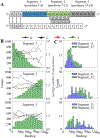Massively Parallel Selection of NanoCluster Beacons
- PMID: 35945159
- PMCID: PMC9588665
- DOI: 10.1002/adma.202204957
Massively Parallel Selection of NanoCluster Beacons
Abstract
NanoCluster Beacons (NCBs) are multicolor silver nanocluster probes whose fluorescence can be activated or tuned by a proximal DNA strand called the activator. While a single-nucleotide difference in a pair of activators can lead to drastically different activation outcomes, termed polar opposite twins (POTs), it is difficult to discover new POT-NCBs using the conventional low-throughput characterization approaches. Here, a high-throughput selection method is reported that takes advantage of repurposed next-generation-sequencing chips to screen the activation fluorescence of ≈40 000 activator sequences. It is found that the nucleobases at positions 7-12 of the 18-nucleotide-long activator are critical to creating bright NCBs and positions 4-6 and 2-4 are hotspots to generate yellow-orange and red POTs, respectively. Based on these findings, a "zipper-bag" model is proposed that can explain how these hotspots facilitate the formation of distinct silver cluster chromophores and alter their chemical yields. Combining high-throughput screening with machine-learning algorithms, a pipeline is established to design bright and multicolor NCBs in silico.
Keywords: NanoCluster Beacons; fluorescent nanomaterials; high-throughput screening; next-generation sequencing; silver nanoclusters.
© 2022 Wiley-VCH GmbH.
Conflict of interest statement
Competing interests
The authors declare no competing interests.
Figures




Similar articles
-
A complementary palette of NanoCluster Beacons.ACS Nano. 2014 Oct 28;8(10):10150-60. doi: 10.1021/nn505338e. Epub 2014 Oct 17. ACS Nano. 2014. PMID: 25299363 Free PMC article.
-
DNA Templated Metal Nanoclusters: From Emergent Properties to Unique Applications.Acc Chem Res. 2018 Nov 20;51(11):2756-2763. doi: 10.1021/acs.accounts.8b00366. Epub 2018 Oct 19. Acc Chem Res. 2018. PMID: 30339358
-
Ratiometric NanoCluster Beacon: A Label-Free and Sensitive Fluorescent DNA Detection Platform.ACS Appl Mater Interfaces. 2017 Apr 19;9(15):13102-13110. doi: 10.1021/acsami.7b03198. Epub 2017 Apr 10. ACS Appl Mater Interfaces. 2017. PMID: 28367619
-
DNA/RNA Detection Using DNA-Templated Few-Atom Silver Nanoclusters.Biosensors (Basel). 2013 Apr 23;3(2):185-200. doi: 10.3390/bios3020185. Biosensors (Basel). 2013. PMID: 25586126 Free PMC article. Review.
-
An Atom-Precise Understanding of DNA-Stabilized Silver Nanoclusters.Acc Chem Res. 2024 Aug 6;57(15):2117-2129. doi: 10.1021/acs.accounts.4c00256. Epub 2024 Jul 12. Acc Chem Res. 2024. PMID: 38995323 Free PMC article. Review.
Cited by
-
AI in SERS sensing moving from discriminative to generative.NPJ Biosens. 2025;2(1):9. doi: 10.1038/s44328-025-00033-2. Epub 2025 Feb 21. NPJ Biosens. 2025. PMID: 39991468 Free PMC article. Review.
-
Massively Parallel Profiling of RNA-targeting CRISPR-Cas13d.bioRxiv [Preprint]. 2023 Mar 28:2023.03.27.534188. doi: 10.1101/2023.03.27.534188. bioRxiv. 2023. Update in: Nat Commun. 2024 Jan 12;15(1):498. doi: 10.1038/s41467-024-44738-w. PMID: 37034598 Free PMC article. Updated. Preprint.
-
Metal Nanocluster-Based Biosensors for DNA Detection.Biosensors (Basel). 2025 Jan 25;15(2):72. doi: 10.3390/bios15020072. Biosensors (Basel). 2025. PMID: 39996974 Free PMC article. Review.
-
A non-FRET DNA reporter that changes fluorescence colour upon nuclease digestion.Nat Nanotechnol. 2024 Jun;19(6):810-817. doi: 10.1038/s41565-024-01612-6. Epub 2024 Feb 13. Nat Nanotechnol. 2024. PMID: 38351231 Free PMC article.
-
Massively parallel profiling of RNA-targeting CRISPR-Cas13d.Nat Commun. 2024 Jan 12;15(1):498. doi: 10.1038/s41467-024-44738-w. Nat Commun. 2024. PMID: 38216559 Free PMC article.
References
-
- Yeh HC, Sharma J, Han JJ, Martinez JS, Werner JH, Nano Letters 2010, 10, 3106. - PubMed
-
- Yeh H-C, Sharma J, Han JJ, Martinez JS, Werner JH, IEEE Nanotechnology Magazine 2011, 5, 28.
MeSH terms
Substances
Grants and funding
LinkOut - more resources
Full Text Sources

